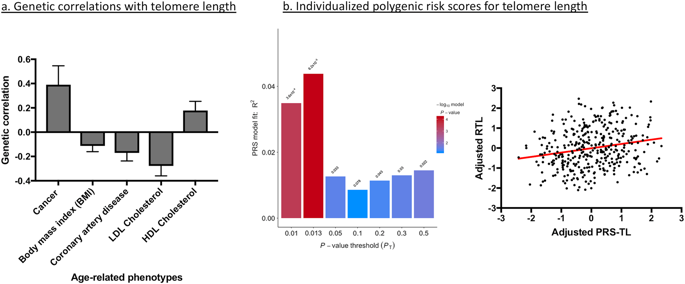当前位置:
X-MOL 学术
›
Neuropsychopharmacology
›
论文详情
Our official English website, www.x-mol.net, welcomes your feedback! (Note: you will need to create a separate account there.)
The polygenic nature of telomere length and the anti-ageing properties of lithium.
Neuropsychopharmacology ( IF 7.6 ) Pub Date : 2018-Dec-18 , DOI: 10.1038/s41386-018-0289-0 Fiona Coutts 1 , Alish B Palmos 1 , Rodrigo R R Duarte 1, 2 , Simone de Jong 1 , Cathryn M Lewis 1, 2 , Danai Dima 3, 4 , Timothy R Powell 1
Neuropsychopharmacology ( IF 7.6 ) Pub Date : 2018-Dec-18 , DOI: 10.1038/s41386-018-0289-0 Fiona Coutts 1 , Alish B Palmos 1 , Rodrigo R R Duarte 1, 2 , Simone de Jong 1 , Cathryn M Lewis 1, 2 , Danai Dima 3, 4 , Timothy R Powell 1
Affiliation

|
Telomere length is a promising biomarker for age-related disease and a potential anti-ageing drug target. Here, we study the genetic architecture of telomere length and the repositioning potential of lithium as an anti-ageing medication. LD score regression applied to the largest telomere length genome-wide association study to-date, revealed SNP-chip heritability estimates of 7.29%, with polygenic risk scoring capturing 4.4% of the variance in telomere length in an independent cohort (p = 6.17 × 10-5). Gene-enrichment analysis identified 13 genes associated with telomere length, with the most significant being the leucine rich repeat gene, LRRC34 (p = 3.69 × 10-18). In the context of lithium, we confirm that chronic use in a sample of 384 bipolar disorder patients is associated with longer telomeres (p = 0.03). As complementary evidence, we studied three orthologs of telomere length regulators in a Caenorhabditis elegans model of lithium-induced extended longevity and found all transcripts to be affected post-treatment (p < 0.05). Lithium may therefore confer its anti-ageing effects by moderating the expression of genes responsible for normal telomere length regulation. This is supported by our bipolar disorder sample, which shows that polygenic risk scores explain a higher proportion of the variance in telomere length amongst chronic lifetime lithium users (variance explained = 8.9%, p = 0.01), compared to non-users (p > 0.05). Consequently, this suggests that lithium may be catalysing the activity of endogenous mechanisms that promote telomere lengthening, whereby its efficacy eventually becomes limited by each individual's inherent telomere maintenance capabilities. Our work indicates a potential use of polygenic risk scoring for the prediction of adult telomere length and consequently lithium's anti-ageing efficacy.
中文翻译:

端粒长度的多基因性质和锂的抗衰老特性。
端粒长度是一种很有前途的年龄相关疾病的生物标志物,也是一种潜在的抗衰老药物靶点。在这里,我们研究了端粒长度的遗传结构和锂作为抗衰老药物的重新定位潜力。LD 评分回归应用于迄今为止最大的端粒长度全基因组关联研究,显示 SNP 芯片遗传力估计为 7.29%,多基因风险评分捕获了独立队列中端粒长度方差的 4.4%(p = 6.17 × 10 -5 )。基因富集分析确定了 13 个与端粒长度相关的基因,其中最重要的是富含亮氨酸的重复基因 LRRC34 (p = 3.69 × 10 -18)。在锂的背景下,我们证实在 384 名双相情感障碍患者的样本中长期使用锂与更长的端粒相关(p = 0.03)。作为补充证据,我们研究了锂诱导延长寿命的秀丽隐杆线虫模型中端粒长度调节剂的三个直系同源物,发现所有转录本在治疗后都受到影响(p < 0.05)。因此,锂可以通过调节负责正常端粒长度调节的基因的表达来赋予其抗衰老作用。我们的双相情感障碍样本支持了这一点,该样本表明,与非锂用户相比,多基因风险评分解释了长期锂用户端粒长度差异的更高比例(解释差异 = 8.9%,p = 0.01)(p > 0.05)。最后,这表明锂可能正在催化促进端粒延长的内源机制的活性,因此其功效最终会受到每个人固有的端粒维持能力的限制。我们的工作表明,多基因风险评分可用于预测成人端粒长度,从而预测锂的抗衰老功效。
更新日期:2019-01-26
中文翻译:

端粒长度的多基因性质和锂的抗衰老特性。
端粒长度是一种很有前途的年龄相关疾病的生物标志物,也是一种潜在的抗衰老药物靶点。在这里,我们研究了端粒长度的遗传结构和锂作为抗衰老药物的重新定位潜力。LD 评分回归应用于迄今为止最大的端粒长度全基因组关联研究,显示 SNP 芯片遗传力估计为 7.29%,多基因风险评分捕获了独立队列中端粒长度方差的 4.4%(p = 6.17 × 10 -5 )。基因富集分析确定了 13 个与端粒长度相关的基因,其中最重要的是富含亮氨酸的重复基因 LRRC34 (p = 3.69 × 10 -18)。在锂的背景下,我们证实在 384 名双相情感障碍患者的样本中长期使用锂与更长的端粒相关(p = 0.03)。作为补充证据,我们研究了锂诱导延长寿命的秀丽隐杆线虫模型中端粒长度调节剂的三个直系同源物,发现所有转录本在治疗后都受到影响(p < 0.05)。因此,锂可以通过调节负责正常端粒长度调节的基因的表达来赋予其抗衰老作用。我们的双相情感障碍样本支持了这一点,该样本表明,与非锂用户相比,多基因风险评分解释了长期锂用户端粒长度差异的更高比例(解释差异 = 8.9%,p = 0.01)(p > 0.05)。最后,这表明锂可能正在催化促进端粒延长的内源机制的活性,因此其功效最终会受到每个人固有的端粒维持能力的限制。我们的工作表明,多基因风险评分可用于预测成人端粒长度,从而预测锂的抗衰老功效。


























 京公网安备 11010802027423号
京公网安备 11010802027423号